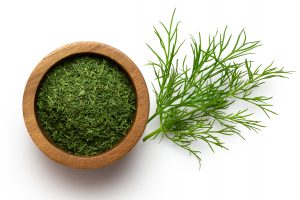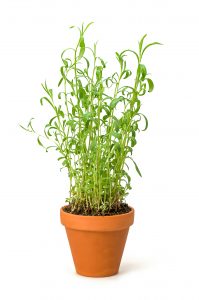Do you use spices and kitchen herbs to improve the taste of food or to do something good for yourself? Did you know that your spice rack can be an excellent medicine cabinet? Use the medicinal power of kitchen herbs and spices as our ancestors did quite naturally.
ANISE – Pimpinella anisum

Anise is one of the oldest known aromatic herbs, it was mentioned on a papyrus as early as 1500 BC. Anise belongs to the umbelliferous family, its fruits (seeds) are harvested in autumn.
Anise contains 6% essential oil, anethole, protein, fat and coumarins. Due to their oil content, the chewed grains have an expectorant effect on respiratory diseases and are also natural bacteria killers. Anise strengthens the stomach and promotes overall digestion. A tea with the crushed fruits is effective for flatulence in the gastrointestinal tract and can be used for infants. The classic tea for babies suffering from flatulence consists of equal parts aniseed, fennel and caraway. For breastfeeding mothers, aniseed has a milk-forming effect.
In homeopathy, Anisum 1D to 4D is also used for flatulence and diarrhoea (10 drops each up to 5 times a day).
In the kitchen, aniseed is often used in baked goods, but it also tastes good as a spice in soups, sauces and young carrots.
Aniseed liqueur:
Mix 40 g fresh, crushed aniseed with 1 g cinnamon stick, ½ kg sugar and 1 L organic grain brandy and fill into a bottle. Leave to infuse for approx. 6 weeks, filter off, store in a cool, dry place. A glass after a meal eliminates a feeling of fullness and gastric distress.
Aniseed curves:
Beat 4 eggs until foamy and gradually add 150g sugar and 1 sachet vanilla sugar. Then beat until a creamy mixture is formed. Sift 120 g flour over the mixture and fold in carefully. Using 2 coffee spoons, place small heaps on a greased baking tray (wide spacing) and sprinkle with aniseed to taste. Place the baking tray in the middle of the oven and bake at a good medium heat (approx. 180° C) for 8-10 minutes. Bend the baked slices while still hot over a wooden spoon and leave to cool. Aniseed bows are an ideal dessert after a heavy meal.
STAR ANISE – Illicium verum

The star anise tree is an evergreen magnolia tree native mainly to China and Vietnam. The ripe fruits are used as a spice and medicinal plant. The Chinese already knew about the healing properties of star anise 5,000 years ago. They used it for digestive and respiratory ailments. We know the fragrant fruits mainly as a spice for Christmas cookies, mulled wine and winter teas. In Asian cuisine, star anise is also found in five-spice powder. This tasty spice blend also contains fennel, clove, cassia cinnamon and Szechuan pepper.
The most important ingredients are essential oils, saponins and shikimic acid. The latter has an antiviral effect by interrupting the chain of infection. Shikimic acid prevents the viruses from detaching from their host cell, thus the viruses can no longer spread further in the body. Shikimic acid is a neuraminidase inhibitor, so to speak, which is why star anise is considered a particularly valuable flu remedy. Star anise can prevent an outbreak of the disease and, in the case of an already existing disease, it can stem the spread of the disease. Due to its antibacterial effect, star anise also prevents the possible bacterial secondary infections of a flu infection (e.g. pneumonia).
In addition to its antibacterial and antiviral effects, star anise is an expectorant, antispasmodic, analgesic, soothing and relaxing. It is helpful for headaches, toothaches, sore throats, earaches and aching limbs, as well as for colds and coughs. Fever blisters, angina and bronchitis are among the uses of this spice. Star anise can also improve lung function in asthma.
It is used in tea mixtures for catarrh of the respiratory tract, digestive complaints with bloating, flatulence, mild cramps and colics. As it increases the amount of glutathione in the body, star anise also has an antioxidant effect. The essential oil of star anise gives a feeling of security and comfort.
To avoid stomach problems, star anise should not be taken on an empty stomach. Do not use in hormone-dependent diseases and during pregnancy. However, star anise is helpful during breastfeeding because it stimulates lactation.
Incidentally, before synthetic production, the active ingredient of the flu drug Tamiflu was made from the ingredients of star anise.
Seasoning mix for dark meat:
1 cinnamon stick, 2 tbsp juniper berries, 10 g dried porcini mushrooms, 3 tbsp dried orange peel, 3 tbsp red pepper, 2 star anise, 2 tsp allspice seeds, 2 tsp cloves, 2 tsp coriander seeds, 2 tsp white peppercorns
To marinate, crush the spices in a mortar and mix with 250 ml red wine.
Mulled wine spice:
Put 2 tbsp cloves, 3 star anise, 3 tbsp dried organic orange peel and 50 g brown (rock candy) sugar in a bowl. Break through 3 sticks of cinnamon once, add these to the other spices and mix everything together. The spice quantity is enough for 1 bottle of red wine or for 750 ml fruit tea.
MUGWORT – Artemisia vulgaris

Mugwort grows wild on nutrient-rich, fresh and moist soils all over Europe and in many other parts of the world, but also on paths, in flood plain scrub and as riparian vegetation.
The young shoots and leaves are used in the kitchen. From April to May, these are still mildly aromatic and not very bitter, but mugwort leaves, as long as they are juicy, can be dried throughout the growing season and used crushed as a spice. Mugwort is suitable as an ingredient for salads, coarsely chopped for omelettes and egg dishes as well as for quiche. The crushed, fresh leaves of the plant make fatty roasts spicier and easier to digest.
Mugwort contains tannins, bitter substances, essential oil, inulin, vitamins A, B and C, thujone; it stimulates the appetite and aids digestion. As a tea, it has a relaxing effect on the nervous system in cases of nervousness and insomnia. Mugwort tea gently stimulates the secretion of the large glands through its germ and fungus inhibiting ingredients, benefiting the stomach, liver, gall bladder and intestines.
Herbal salt for fatty dishes:
3 parts rock salt, 2 parts dried organic thyme, 1 part dried organic rosemary and 1 part dried mugwort. Mix the ingredients in a container and grind them together. Store in a dry and dark place.
Mugwort wine:
Mix 20 g of mugwort leaves with 1 pinch of rosemary and 1 pinch of peppermint and pour over 0.75 l of sweet white wine. Leave to infuse for 10 days in a sealed glass jar, strain and bottle. 1 liqueur glass before a meal helps with indigestion. Mugwort wine is also beneficial for menstruation.
BASIL – Ocimum basilicum

Basil belongs to the labiates family and is popularly called royal herb, royal balm, basil herb and pepper herb. The whole plant smells intensely fiery and spicy. The home of basil is thought to be the tropical region of the Indian subcontinent, and basil wreaths have even been discovered in the burial chambers of the pyramids. Even the ancient Greeks valued the spicy and healing herb. Basil arrived in Central Europe around the 12th century.
The fresh plant should also be kept in a flower pot on the windowsill in winter. Basil should only be used fresh, dried basil loses much of its flavour. Gourmets pluck or crush the leaves (instead of cutting them) and never cook them.
The entire herb is used. It goes well with tomatoes & mozzarella, herb sauces, soups, salads, herb butter, egg dishes, meat, shellfish, peppers, aubergines and cheese dishes.
Basil tea is effective as a fever and sweating tea, for stomach and digestive disorders, constipation, flatulence and insomnia.
Pesto alla Genovese:
Preparation in the mortar: put 250 g basil leaves, 3 tsp pine nuts, 1 tsp rock salt, 3 heaped tsp freshly grated Parmesan in the mortar, slowly add 1/4 l virgin organic olive oil to the mortar and rub everything together. Season with freshly ground pepper and a pinch of freshly grated nutmeg. Pour into a screw-top jar. Keeps in the fridge for a few weeks. Always make sure the pesto is covered with oil.
Basil sauce with pasta, soups and vegetable dishes:
Strip the leaves from 2 large bunches of basil. Blend approx. 150 ml cold-pressed organic olive oil and 2 large, peeled, sliced organic garlic cloves; briefly blend in the basil leaves. Leftovers will keep in a screw-top jar in the fridge for about 2 weeks.
SAVORY – Satureja hortensis (Summer savory – annual) / Satureja montana (Winter savory – perennial)

Savory belongs to the labiates family and originates from Mediterranean countries. It grows in any good garden soil. The whole flowering herb can be collected from July to September.
Summer savory herb smells strongly spicy, it tastes somewhat peppery and a little acrid. The perennial mountain savory, also called winter savory, likewise tastes spicy and a little acrid. Both varieties have the same ingredients: essential oil, tannins, mucilage, carvacol, thymol and cymol. Savory strengthens the stomach, heart and digestion; it has a flatulence-reducing, mood-enhancing and anti-inflammatory effect.
Savory is also suitable for fumigation: burn whole twigs in an incense bowl to disinfect rooms and for aromatic good smell.
Savory is used in bean dishes, bean salad, lentil and pea dishes, as a seasoning herb for soups, stews, potato dishes, meat, fish, herb omelettes and sauces.
The tea made from the dried or fresh leaves helps with stomach cramps, mouth and throat disorders and cold symptoms.
SAVORY TONIC: (Restorative after debilitating fever)
Put 1 handful of fresh savory in a glass bottle, cover with 0.75 l of good organic red wine, leave sealed in a cool place for 10 days and then filter off. Enjoy by small glasses.
Savory salt:
Mix ½ kg rock salt with 1/8 l dried, crushed savory and grind finely, fill into screw jars and store in the dark.
 BORAGE – Borago officinalis
BORAGE – Borago officinalis
Borage belongs to the rough-leaf family and is popularly known as starflower. The Celtic word stem “borrach” (= courage) says a lot about the plant.
At the time of Hildegard von Bingen, borage was already grown as a garden plant in the monastery gardens. There are also wild plants on wasteland.
The whole flowering herb of borage (flowering time: June-August) is used. Borage tastes fresh and somewhat acidic, and the leaves emit an intense cucumber smell. In the kitchen, fresh and preferably young leaves are used for salads, sauces and fish dishes, egg dishes, spinach and chard vegetables, curd spreads and for pickling cucumbers. Folk medicine mentions the tea made from flowers and leaves fresh or dried to stimulate the nervous system, to strengthen the mind and brain and to brighten the mood.
Borage contains mucilage and tannins, saponins, little essential oil, silicic acid, asparagine, resins, vitamin C and pyrrolizidine alkaloids. It strengthens the heart, soothes irritations, expectorates, purifies the blood, invigorates, strengthens the nerves and reduces fever.
Tzatziki with borage:
Goes perfectly with roasted or grilled meat or fish, but also with grain or vegetable patties. Only mix ingredients:
400 g Greek yoghurt, 1 organic cucumber finely grated, approx. 10 young borage leaves finely chopped, juice of ½ organic lemon, 1 tbsp. organic olive oil, 1 clove of pressed garlic, salt, pepper, borage flowers for sprinkling.
Cold cucumber yoghurt soup with borage:
Dice 1 organic cucumber with the peel, puree with ½ – ¾ litre yoghurt, 1 clove of garlic and 2 young borage leaves in a blender, season with pepper and chill. Garnish the soup with chopped walnuts and serve cold.
DILL – Anethum graveolens

The umbelliferous plant, imported from Asia and now native to Europe, is a classic garden plant; wild dill can be found in fields, along roadsides and in wasteland. The name dill comes from the Norwegian “dilla”, which means “to put to sleep”.
Like caraway, fennel and aniseed, dill belongs to the so-called “carminatives”, which are plants that relax the muscles of the gastrointestinal tract and act against bacteria. Dill weed and flowers have an anti-inflammatory effect. Dill in the form of seasoning or tea eliminates flatulence, stimulates the appetite, has a diuretic effect, but also calms and combats insomnia. Dill seeds can be made into a sleep-inducing footbath or enjoyed as a tea according to the same recipe: pour 1 tsp. of seeds into 1 cup of boiling water, steep for 10 min., strain and enjoy. Dill tastes spicy, it goes well with cucumbers, courgettes, tomatoes, cream cheese and in egg dishes.
Cold dill dressing for salads:
5 tbsp freshly chopped dill or 2-3 tbsp dried dill with 3 tbsp organic sour cream, 1 tbsp organic apple cider vinegar, 1 small onion finely chopped, 1 tsp medium hot organic mustard some salt and pepper. Especially tasty for cucumber and courgette salads.
Warm dill sauce:
Brown 100 g organic flour in 50-100 g organic butter until golden, pour in 1 ½ litres of stock ( vegetable or meat or bone), boil down for 20 minutes. Add 4 tbsp. freshly chopped dill or 4 tbsp. dried dill, bring to boil once, season with sour cream. Goes well with meat and vegetable patties and with stewed beef.
TARRAGON – Artemisia dracunculus

Tarragon is a perennial composite plant that is mainly known as a cultivated plant or garden plant. It originates from Asia and came to Europe through the Crusaders. The name tarragon is derived from “draco” (= dragon, snake).
Only the upper third of the plant without the stem is used. Tarragon leaves should always be used fresh, dried leaves have little strength. To preserve tarragon, place it in vinegar, oil or alcohol; it can also be frozen in portions (in ice cube trays).
Tarragon contains essential oil, tannins, bitter substances, flavonoids, plant acids, tarragol, anethole, limonene, potassium. Tarragon leaves are also rich in iodine, mineral salts, vitamins A and C. The plant has a digestive, appetising and diuretic effect.
Tarragon vinegar:
Add 3 tarragon sprigs to 1 litre of organic apple cider vinegar, close well and keep in a warm place, strain after 2-3 weeks, store in a cool, dark place. A tasty vinegar for salads.
Tarragon mushrooms:
Clean 750 g white or brown organic mushrooms. Bring 750 ml water to the boil in a large saucepan, add 2 tbsp rock salt and the mushrooms and cook, covered, over a low heat for about 5 minutes. Pour the mushrooms into a sieve and drain. Bring 750 ml water to the boil with 150 ml tarragon vinegar (see above for recipe). Peel 150 g small shallots and 4 cloves of garlic, halve the garlic. Add both with the mushrooms to the vinegar water and cook uncovered for about 5 minutes.
Remove the mushrooms, shallots and garlic from the broth with a slotted spoon into a sieve. Let the broth simmer for about 5 minutes more. Layer 2 stalks of tarragon with the mushrooms, shallots and garlic in a large jar with a swing top (1 litre), pour 400 ml of the hot stock through a sieve over the mushrooms and pour 150 – 200 ml of organic olive oil over the top. Seal the jar immediately and leave the mushrooms to marinate for approx. 2 weeks. Can be kept unopened for at least 3 months.
FENNEL – Foeniculum vulgare
 The biennial umbellifer was originally at home in the Mediterranean region and the Near East, but is now cultivated throughout Europe, Asia, parts of South America and Africa. The flower-rich and nectar-rich fennel is a popular bee forage.
The biennial umbellifer was originally at home in the Mediterranean region and the Near East, but is now cultivated throughout Europe, Asia, parts of South America and Africa. The flower-rich and nectar-rich fennel is a popular bee forage.
Fennel was already a highly valued plant in the ancient civilisations of China, Egypt and Arabia. Dioscorides (military physician in the 1st century AD) recommended it to women for lactation, against nausea and to strengthen the eyesight. The Romans valued fennel as a spice herb and as a salad plant. Later, it was the monks who planted the fennel as a spice and medicinal herb.
In homeopathy, Foeniculum 1D to 2D is used for lactation in breastfeeding women, for flatulence, to strengthen the eyes, for coughs and asthma (up to 10 drops several times a day).
Inhalation with fennel steam:
Boil 3 tablespoons of fennel seeds with 1 litre of water, remove the pot from the cooker, inhale the fennel steam for about 10 minutes. To do this, bend over the pot and cover your head with a towel so that the steam hits the face area intensively. Inhale and exhale deeply, rest in bed for 1 hour after inhalation. This inhalation is helpful for coughs, respiratory diseases and lung ailments.
Internally, fennel is used for flatulence with cramp-like complaints in the gastrointestinal tract, bloating or loss of appetite (mixture with caraway is recommended), digestive disorders in babies with diarrhoea, as an expectorant for colds (mixture with aniseed is recommended), to promote lactation in breastfeeding mothers and for calming.
Fennel oil: (externally for massaging or for flavouring food)
Grind 3 tbsp. fennel seeds and leave in 100 ml cold-pressed organic sunflower oil on the windowsill for 3 weeks, shaking a little every day. Then strain, store in a cool and dark place. If necessary, warm 1-2 tablespoons of fennel oil in a bain-marie, put it on the palms of your hands and gently massage it into the baby’s tummy or massage it into the chest and back in case of a cough with thick mucus. This fennel oil also finely flavours dishes
Fennel aniseed milk:
Stir 1 teaspoon each of freshly ground fennel and anise seeds into a cup of hot milk, let stand for 5-10 minutes, drain and sweeten with honey. Suitable for coughs and insomnia.








